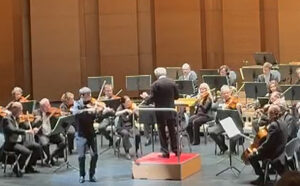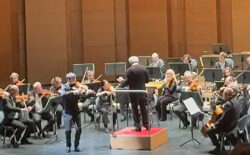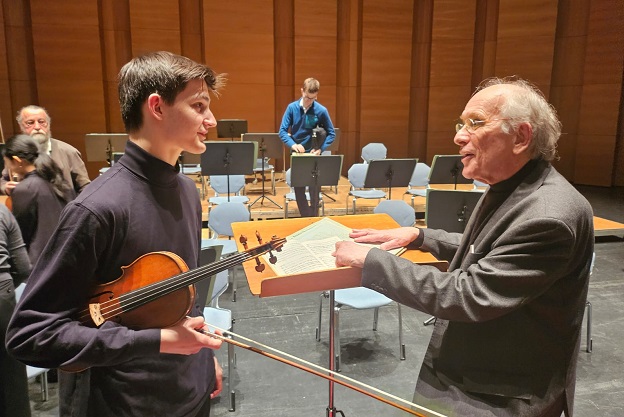The Westdeutsche Sinfonia organized a concert at the Forum Leverkusen this weekend as part of the ICMA Network for Young Artist Awards. The soloist was 18-year-old Austrian violinist Leonhard Baumgartner, winner of the ICMA Discovery Award 2023. Remy Franck reports.
Robert Schumann’s Overture, Scherzo and Finale op. 52 was the first of three works by three composers, Schumann, Mozart and Mendelssohn, all of whom died in their thirties or forties.
Dirk Joes brought a great deal of expressiveness, rhetoric and fresh spontaneity to this rarely heard composition. The conductor’s rhythmic sense was striking, keeping the music pulsating and flowing, organically linking the themes of the three movements without those micro-pauses that, in other conductors’ hands, lead to a stringing together of motifs rather than an architecturally overarching interpretation. Dirk Joeres, a proven specialist in Schumann, did justice to this work and enriched it considerably.
Leonhard Baumgartner, Discovery Award winner of the 2023 International Classical Music Awards, was the soloist in Mozart’s Fifth Violin Concerto, K. 219. He won the 2023 ICMA Award as a scholarship student at the International Academy of Music in Liechtenstein.
The only eighteen-year-old violinist approached the first movement with youthful freshness, quite spirited and at times downright boyish. He made an immediate impression with his genuine musicality and joy of communication. He played in total admiration of Mozart’s divine art and with the joy that welled up in him to make Mozart’s art audible.
This was followed by a soulful, tender, and deeply felt Adagio, in which the sweet pain of this music was movingly expressed.
 With the sheer elegance of his agile, extremely flexible playing and his complete command of a work he was performing for the first time, the young soloist enthralled the audience in the Leverkusen Forum. He was not allowed to leave without an encore, and he played Paganini’s Caprice No. 21, L’Amoroso, brilliantly and technically stupendous as well as very musically expressive, a piece, which with its Italian character was the perfect transition to Mendelssohn’s Italian Symphony. Baumgartner’s Paganini was an ideal combination of polish, clarity and the poetic-romantic sensibility that is often lacking in this composer.
With the sheer elegance of his agile, extremely flexible playing and his complete command of a work he was performing for the first time, the young soloist enthralled the audience in the Leverkusen Forum. He was not allowed to leave without an encore, and he played Paganini’s Caprice No. 21, L’Amoroso, brilliantly and technically stupendous as well as very musically expressive, a piece, which with its Italian character was the perfect transition to Mendelssohn’s Italian Symphony. Baumgartner’s Paganini was an ideal combination of polish, clarity and the poetic-romantic sensibility that is often lacking in this composer.
Finally, Dirk Joeres conducted Mendelssohn’s Fourth Symphony, the Italian. From the very first movement, it was evident how the music flows with this conductor, without ever becoming fluid or smooth. In this interpretation, the glorious richness of Mendelssohn’s orchestration came to the fore. With clear, shaping beats that every orchestra must feel comfortable with, Joeres also achieved a transparency in the sound that no sound engineer could achieve better with the controls of his mixing console.
After this radiantly bright first movement, the second movement was conducted in a very lively and alert manner. It did not become a berceuse, as some conductors have done, but remained an andante, despite all its lyricism. This was followed by a wonderfully lyrical third movement, before the finale brought the symphony to a close with sparkling virtuoso musical fireworks and a stupendous richness of sound.


















